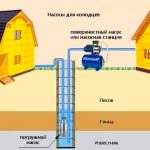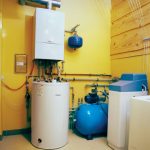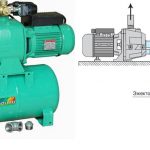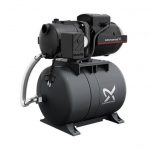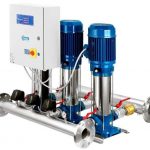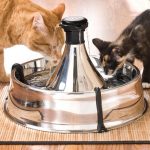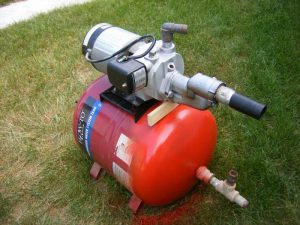 Outside the main water supply, only a pumping station for a well can provide a country cottage or cottage with water for life and watering a personal plot. With its effective help, fluid intake is carried out on an ongoing basis, and the pressure that is created in the pipes is enough for all the needs of users, because some models are able to serve several water intake points at the same time.
Outside the main water supply, only a pumping station for a well can provide a country cottage or cottage with water for life and watering a personal plot. With its effective help, fluid intake is carried out on an ongoing basis, and the pressure that is created in the pipes is enough for all the needs of users, because some models are able to serve several water intake points at the same time.
To find out the selection methodology, the correct connection and the frequency of service, as well as the necessary technical parameters, you need to carefully read our article.
Content
What it is
An engineering design consisting of pumping equipment necessary for reliable operation, which is designed to pump water from a specific tank - natural or artificial, is called a pumping station. With a quality installation by professionals, it minimizes all the problems of providing drinking water to a private house or individual buildings where there is no water supply.
Unlike conventional pumps:
- water supply is organized with process automation;
- the station independently increases pressure, which is very important for watering and at the same time providing for the needs inside the house;
- with the help of a pumping station, you can create water supplies - for this, a special container is installed to use it when the lights are suddenly turned off.
Today, these products are used everywhere, because they are unique pumping equipment that can provide water from a natural reservoir or specially dug wells and boreholes.
Types of units for wells
By design, the pumping units that the wells are equipped with are no different from the analogues used for wells. Advantage - you can use any station with a submersible pump, because its diameter does not matter, because it will sink under water, and not into the well pipe.
In this case, two types of aggregates are used: vibrational and centrifugal, and many factors affect their choice:
- What depth does the well have, at what level is the water.
- What volume of liquid stably flows to the tank from which the pump station pumps it.
- What is the total need to be provided daily.
- The magnitude of the pressure to supply water to any point on the site.
All pumping stations are divided according to:
- From suction type:
- with a mounted ejector - they lift water from a depth of not more than 8 meters, are insensitive to small debris, work quite loudly, therefore they are installed in the utility room;
- The remote ejector allows pumping water from a depth of up to 50 m, it works quietly, but is sensitive to suspended particles - filters must be installed.
- By type of additional capacity:
- a storage tank for water is installed in the attic, so that when the light is turned off, it can flow to the water intake points naturally, because of the threat of flooding and large dimensions, this option is not used much;
- a diaphragm tank, the filling level is regulated by a hydraulic accumulator, such a capacity is installed in a heated basement.
- Source of water supply:
- when the ejector is located at the top, and under the water there is only a hose, fairly easy operation and maintenance, you only need to install a filter to protect the pump from small debris;
- deep devices - the suction device has a waterproof housing, so it is fully deepened, they are more economical, easy to install and dismantle.
For the third option, you can use drainage pumps that perfectly cope with liquids of any pollution.
Specifics of choice
All stations are divided into industrial and domestic, which are installed in a country house or a country house, where a large throughput is needed during the day. Before choosing a model, it is necessary to compare its performance with the future amount of work - this parameter should coincide or slightly exceed the user's needs.
If you choose the right pump station, then it is capable of uninterrupted water supply for the entire residential complex on your site, plus a garden and garden irrigation system, regardless of operating conditions.
Specifications
They should be such that the equipment can constantly meet the needs of users and maintain optimal pressure in the system.
Pressure
This parameter can easily be calculated independently using the following formula: H = (Hn + Hi + L / 10 + Hd), where Hn is the nominal pressure of 1.5-3.0 bar; Hi - suction depth; L is the distance from the installation site of the pump to the building; Hd is the height of the water intake points above the supply pipe.
Performance
To calculate this parameter, you need to calculate all the points of analysis of water and determine the total volume in liters that passes through them in a minute. Then translate the result into a standard cube value. m / hour. The electric motor power, which for domestic pumping stations varies between 0.5-2 kW, must correspond to the performance - only in this case there will be a normal pressure in the pipeline.
In the technical passport of any model you will find this data, just do not select power with a large margin - this option will lead you to excessive energy costs.
Storage capacity
The frequency of turning on the pump depends on the size of the hydraulic accumulator, as well as the reserve reserve in case of an unexpected blackout.
The usable volume is not more than 30-45%, it depends on the settings of the pressure switch and the air pressure created during filling, which has values from 0.8 to 4.0 atmospheres.
Technical parameters of pumping stations
Each manufacturer provides complete information on the technical characteristics of the produced models for autonomous water supply, and the similar parameters of the popular pumping stations can be found by studying the attached table.
| Product type | Productivity cube m / hour | Head height, m | power, kWt | The volume will accumulate. tank, l | Suction depth, m |
| Mini | 2,7 | 45 | 0,55 | 1 | 7 |
| Fence up to 7 m | 4,2 | 46 | 1,1 |
24(50) |
|
| Fence up to 9 m | 5,4 | 60 | 1,1 | 9 | |
| With ejectors | 5,1 | 80 | 0,75 | 35 |
Automation of pumping stations
It plays a very important role when using a device for pumping fluid, which is taken from a natural reservoir, for example, a lake, river or artificial - well, well. The pump pumps water into the hydraulic accumulator or a large metal tank, when the pressure reaches the optimum value, the automatics shuts down the unit.
If there is a water intake from the system, then the pressure decreases and the automation switches on the suction pump. It is the relay that is responsible for all these actions, and the user can follow the pressure gauge by changing the pressure.
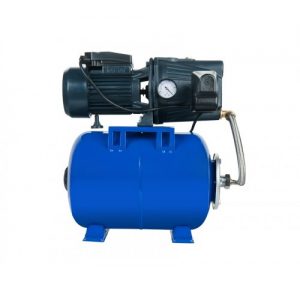
Installation and Connection
When planning the placement of a pumping station with subsequent connection to an internal water supply, the user should take into account the following points:
- The unit must be located next to the water source, so as to ensure constant liquid absorption and smooth operation of the product.
- For installation, choose or equip a dry, warm room with good ventilation.
- The station should be located so that its body does not touch the walls or other objects.
- It is desirable to maximize access for preventive maintenance and repair work.
Therefore, there are several options for placing pumping stations.
In home
Ideal when there is a heated utility room with good sound insulation, for example, a boiler room. If a station with a remote ejector is used, then sound insulation is not critical.
Basement
It is good if the private building has a ground floor, where additional facilities for a gas boiler, garage and other household rooms are equipped. They must be heated or in winter the temperature in them never drops below 0 ° C. Hydro and sound insulation is welcomed, free access to the unit from all sides should be provided.
Well
To place the station directly in the structure of the well, a small platform is installed below the freezing boundary of the soil.
A small room should be large enough to accommodate the pumping station and free access to all parts, and it is well insulated for periods of cold weather.
If a station with a submersible pump is used, then there is no need to worry about sound insulation, since the pump is under water and you cannot hear its operation, while all the elements of the station can be installed in any heated room. This option is optimal for summer cottages, the assembly scheme can be improved if it is planned to connect several points of water intake.
findings
There are quite a lot of models of modern pumping stations, and each user can choose an option acceptable for himself, especially since manufacturers take into account any nuances of placement.
